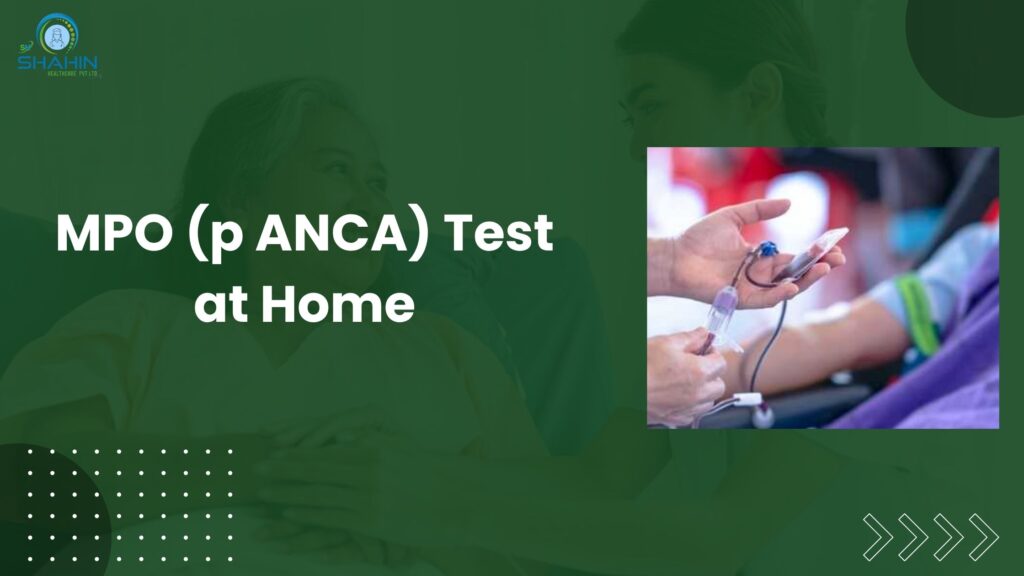In today’s world of modern healthcare, early diagnosis plays a crucial role in preventing life-threatening diseases. Among the many diagnostic tests available, the MPO (p ANCA) Test has become an essential tool for identifying autoimmune disorders and cardiovascular risks.
Thanks to advanced home healthcare services, you can now book an MPO (p ANCA) Test at home, allowing for comfort, convenience, and reliable medical supervision without stepping out of your home.
This detailed guide explains everything about the MPO (p ANCA) Test, including its purpose, how it works, preparation requirements, result interpretation, and why at-home testing is becoming increasingly popular.
1. What is MPO (p ANCA)?
Before we dive deep, let’s understand the basics — MPO full form in medical is Myeloperoxidase. It is a peroxidase enzyme that exists abundantly in neutrophil granulocytes, a specific type of white blood cell responsible for fighting infections.
The MPO enzyme plays a key role in our immune defense mechanism by producing toxic substances to kill invading pathogens. However, in certain conditions, the immune system mistakenly produces antibodies against this enzyme. These antibodies are called Perinuclear Anti-Neutrophil Cytoplasmic Antibodies (p ANCAs).
These autoantibodies can cause inflammation and damage to blood vessels — a condition medically referred to as vasculitis. The presence of MPO antibodies (p ANCA) in the blood can indicate diseases like:
-
Microscopic Polyangiitis (MPA)
-
Wegener’s Granulomatosis (now called Granulomatosis with Polyangiitis)
-
Churg-Strauss Syndrome (Eosinophilic Granulomatosis with Polyangiitis)
Additionally, MPO levels in the blood can also signal risks of:
-
Atherosclerosis
-
Coronary artery disease
-
Myocardial infarction (heart attack)
-
Other cardiac events linked to inflammation
2. How Does MPO Work?
The Myeloperoxidase (MPO) enzyme is a heme-containing protein that participates in the body’s immune defense. When neutrophils encounter bacteria or viruses, MPO uses peroxide and halide ions to create reactive oxygen species — substances capable of killing harmful microorganisms.
However, beyond its infection-fighting role, MPO also contributes to inflammatory processes that, when uncontrolled, can harm the body.
For instance:
-
Excess MPO activity can lead to oxidative stress, which damages healthy tissues.
-
It can promote plaque formation in arteries, increasing the risk of heart disease.
-
Chronic inflammation caused by MPO can contribute to autoimmune disorders like vasculitis.
Thus, maintaining a balanced MPO level is crucial for both immune protection and cardiovascular health.
3. What is the Myeloperoxidase Test?
The Myeloperoxidase Test, also known as the MPO blood test, measures the levels of MPO antibodies in the blood. This test helps detect abnormal immune activity, inflammation, and the presence of autoimmune diseases.
Purpose of the MPO Blood Test
Doctors recommend this test when patients exhibit signs of:
-
Chest pain or suspected cardiac inflammation
-
Fatigue and fever
-
Abnormal heart rhythms
-
Joint pain or muscle aches
-
Skin rashes
-
Persistent cough or breathing issues
The MPO (p ANCA) Test is often performed in combination with other diagnostic tests such as:
-
Electrocardiogram (ECG) – to assess heart rhythm
-
Cardiac Biomarkers Test – to evaluate heart muscle damage
-
C-Reactive Protein (CRP) – to measure inflammation
Together, these tests provide a comprehensive view of the patient’s cardiovascular and autoimmune health.
4. When Do You Get the Results?
One of the advantages of the MPO (p ANCA) Test at home is the quick turnaround time. Typically, you can expect your results within 24 to 36 hours after sample collection. The results are then reviewed by certified medical professionals to ensure accuracy before being delivered to you digitally or in print.
5. Why Get Tested?
Your doctor may recommend an MPO blood test if you’re experiencing symptoms that suggest autoimmune inflammation or vascular damage.
The test helps in detecting disorders such as:
-
Microscopic Polyangiitis (MPA) – a condition that causes inflammation of small blood vessels.
-
Wegener’s Granulomatosis (Granulomatosis with Polyangiitis) – affecting the lungs, kidneys, and upper respiratory tract.
-
Eosinophilic Granulomatosis with Polyangiitis (Churg-Strauss Syndrome) – leading to asthma, sinusitis, and organ damage.
By identifying MPO antibodies early, healthcare providers can begin treatment before the disease progresses to severe stages, preventing long-term complications.
6. Reasons to Take the MPO (p ANCA) Test
The MPO (p ANCA) Test is recommended for individuals who show early symptoms of immune-mediated vasculitis. These symptoms might be mild in the beginning but can progress over time.
Early-Stage Symptoms
-
Persistent fever
-
Fatigue and tiredness
-
Weight loss without a clear reason
-
Joint or muscle pain
-
Night sweats
Progressive Symptoms (Affecting Different Organs)
-
Eyes: Red, itchy eyes, blurred vision, or conjunctivitis
-
Ears: Hearing loss or frequent ear infections
-
Nose: Persistent runny nose or sinus congestion
-
Skin: Development of rashes, nodules, or granulomas
-
Lungs: Shortness of breath, cough, or chest discomfort
-
Kidneys: Presence of protein in urine (proteinuria), indicating kidney inflammation
Early testing ensures timely diagnosis and management before irreversible damage occurs.
7. Preparations Needed for MPO (p ANCA) Test
The best part about the MPO blood test is that it requires no fasting or special preparation.
-
You can eat and drink normally before the test.
-
However, it is advisable to inform your healthcare provider about any medications or supplements you’re taking, as some might influence the results.
This makes the test convenient, especially for at-home sample collection services.
8. Sample Required
The MPO (p ANCA) Test requires a blood sample (serum) for analysis.
Sample Collection Process:
-
Method: Venipuncture – A trained phlebotomist will collect a small amount of blood from a vein, usually from your arm.
-
Duration: The procedure takes only a few minutes.
-
Safety: The process is safe, minimally invasive, and done using sterile equipment to prevent infection.
When booked as an MPO (p ANCA) Test at home, the sample collection is done at your preferred location by a certified healthcare professional.
9. How Can We Help? (At-Home Testing Service)
At-home testing services have made medical diagnostics more accessible than ever. Instead of visiting a lab or hospital, you can now book an MPO (p ANCA) Test at home and have your sample collected safely and conveniently.
Here’s How It Works:
-
Book Online or via Call: Choose the test and provide your details such as name, city, and mobile number.
-
Home Visit: A trained healthcare professional visits your home at your preferred date and time.
-
Sample Collection: A quick blood draw (venipuncture) is performed hygienically.
-
Testing: The sample is transported to a certified lab for analysis.
-
Report Delivery: The results are shared within 24–36 hours through email or hard copy delivery.
Benefits of MPO (p ANCA) Test at Home:
-
Comfort and convenience – no travel or waiting in queues
-
Safe and hygienic procedures
-
Certified phlebotomists ensuring accuracy
-
Affordable testing packages
-
Personalized scheduling and doorstep report delivery
With such benefits, at-home healthcare is becoming the preferred choice for individuals seeking professional and time-efficient medical testing.
10. Understanding Results
Interpreting the MPO (p ANCA) Test results is critical for accurate diagnosis.
| Reference Range | Interpretation |
|---|---|
| Below 20 RU/ml | Negative (No significant MPO antibodies found) |
| 20 RU/ml and above | Positive (Presence of MPO antibodies detected) |
What a Positive Result May Indicate:
If your MPO levels are elevated (for instance, above 539 pM), it may suggest:
-
Atherosclerotic plaque instability
-
Chronic inflammation
-
Myocardial infarction
-
Autoimmune vasculitis
However, it’s important to remember that the MPO blood test alone is not diagnostic. Doctors will correlate your results with other findings such as clinical symptoms, ECG results, and cardiac biomarker levels to determine the exact cause.
11. Factors That May Affect MPO Levels
Several factors can influence MPO readings, including:
-
Smoking – increases oxidative stress and MPO activity
-
Infections – can temporarily elevate MPO levels
-
Chronic diseases – like diabetes or high cholesterol
-
Age and gender – may affect the reference range slightly
That’s why test interpretation should always be done by a qualified physician.
12. The Role of MPO in Heart Health
Recent research suggests that MPO is not just an infection-fighting enzyme but also a biomarker for cardiovascular disease. Elevated MPO levels are often linked with:
-
Plaque formation in arteries
-
Endothelial dysfunction (impaired blood vessel function)
-
Risk of heart attack due to plaque rupture
Therefore, monitoring MPO levels through periodic testing can help in early detection of potential heart-related risks.
13. How MPO Test Supports Autoimmune Disease Management
For patients with autoimmune vasculitis, MPO antibodies act as a guide for diagnosis and treatment monitoring.
-
If treatment is effective, MPO antibody levels tend to decrease.
-
Persistently high levels may indicate ongoing inflammation or relapse.
Hence, doctors may order this test periodically to track disease progression or remission.
14. FAQs
Q1. What is the MPO full form in medical?
A: The MPO full form in medical is Myeloperoxidase, an enzyme found in white blood cells that plays a key role in immune defense and inflammation.
Q2. What is an MPO blood test used for?
A: The MPO blood test helps measure Myeloperoxidase antibody levels to detect autoimmune diseases like vasculitis, and assess heart disease or inflammation risks.
Q3. Do I need to fast before the MPO (p ANCA) Test?
A: No fasting is required. You can eat and drink normally before the test.
Q4. How long does it take to get the results?
A: Typically, the results are available within 24 to 36 hours after the sample is collected.
Q5. Can I book the MPO (p ANCA) Test at home?
A: Yes, with home healthcare services, you can easily book the test at home and have your blood sample collected safely by a professional.
Q6. Is the MPO test painful?
A: The test involves a simple venipuncture (blood draw) and causes only mild, temporary discomfort.
Q7. What does a positive MPO test result mean?
A: A positive result indicates the presence of MPO antibodies, which could be associated with autoimmune or inflammatory conditions.
Q8. Can lifestyle changes influence MPO levels?
A: Yes, adopting a healthy lifestyle — avoiding smoking, eating an anti-inflammatory diet, and managing stress — can help regulate MPO activity.
15. Conclusion
The MPO (p ANCA) Test is a vital diagnostic tool for detecting autoimmune disorders and assessing cardiovascular risks. By identifying abnormal levels of Myeloperoxidase antibodies, healthcare professionals can diagnose conditions like vasculitis early and prevent severe organ damage.
With the convenience of MPO (p ANCA) Test at home, you no longer need to visit crowded labs or hospitals. From sample collection to report delivery, everything can be handled from the comfort of your home with professional care.
Regular health monitoring, timely testing, and professional guidance can make a huge difference in maintaining long-term wellness. If you’re experiencing symptoms such as fatigue, joint pain, or unexplained inflammation, consult your doctor and consider getting the MPO blood test done at home today.

